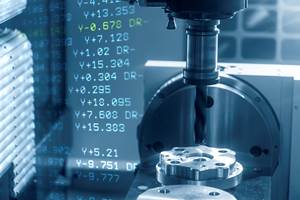Understanding 3D Coordinate Conversion
Applications for five-axis machining fall into two distinct categories. The first is related to machining very complex shapes, as is required in aerospace and the mold industry.
Share






Applications for five-axis machining fall into two distinct categories. The first is related to machining very complex shapes, as is required in aerospace and the mold industry. When machining 3D shapes, it is often advantageous (if not necessary) to keep the cutting tool perpendicular to the surface being machined. This is possible through the articulation of three linear axes (X, Y and Z) and two rotary axes (commonly A and B). Since this kind of work tends to be so complex, a CAM system is required to create the CNC program.
A second application for five-axis machining (the one we address in this column) is not nearly as complex. Many workpieces have surfaces to be machined that are not at right angles. The five axes (again, X, Y, Z, A and B) are simply required to expose the surface to the spindle for machining. Once exposed, machining will occur in a relatively simple plane. Most five-axis programmers in this category would agree that you need a CAM system to create programs for this application, even for simple operations such as drilling, due to the unusual surface angles involved.
You probably know that all simple three-axis CNC machining center controls allow you to specify plane selection commands. G17 is commonly used to specify the X/Y plane, G18 for X/Z and G19 for Y/Z. However, these commands require that the surfaces to be machined be in 90-degree increments. These commands are helpful with right angle heads and allow many of the same programming features that are used in the X/Y plane to be used in X/Z and Y/Z planes.
While these simple plane selection commands are very helpful for three-axis machining centers, they do little to help five-axis machining center programmers. Again, surfaces that must be machined are often not at simple right angles to one another. The 3D coordinate conversion allows the programmer to define a plane for any surface in which machining is to take place. In essence, it allows variable plane selection. As with G17, G18 and G19, once a plane is defined, almost all programming features allowed in the X/Y plane will be available in the plane being defined. This can dramatically simplify the programming of five-axis machining centers. In some applications, programmers are actually able to develop programs manually. Again, all machining is taking place in a simple two-direction plane.
Controls vary when it comes to just exactly how you define the plane in which machining is to be done. One popular control manufacturer uses a G68 command for this purpose. In this command an X, Y and Z value specify a point through which the plane will be passing. Additionally, an I, J or K value specifies the axis that the plane will be rotated about (I for X, J for Y, K for Z). An R word in the command specifies the angle of rotation for the plane (from normal). The command N020 G68 X0 Y0 Z0 I0 J1 K0 840.0 for example, will define a plane that passes through the program 0 point. It will be rotated at 40 degrees about the Y axis. Note that this is still a relatively simple plane. By adding a second G68 command we could continue defining the plane to be used for machining, rotating it in two directions. Again, any surface to be machined on the workpiece can be defined in this manner, regardless of how complex the plane.
If you're going to be purchasing a five-axis machining center for work in this category, we'd urge you to look into this program simplifying feature.
Related Content
Tips for Designing CNC Programs That Help Operators
The way a G-code program is formatted directly affects the productivity of the CNC people who use them. Design CNC programs that make CNC setup people and operators’ jobs easier.
Read MoreObscure CNC Features That Can Help (or Hurt) You
You cannot begin to take advantage of an available feature if you do not know it exists. Conversely, you will not know how to avoid CNC features that may be detrimental to your process.
Read More4 Manufacturing Trends That Cannot Be Ignored
The next five years will present their own unique set of challenges, and shops can alleviate them by embracing these technologies and trends.
Read MoreHow to Meet Aerospace’s Material Challenges and More at IMTS
Succeeding in aerospace manufacturing requires high-performing processes paired with high-performance machine tools. IMTS can help you find both.
Read MoreRead Next
Machine Shop MBA
Making Chips and 91ÊÓƵÍøÕ¾ÎÛ are teaming up for a new podcast series called Machine Shop MBA—designed to help manufacturers measure their success against the industry’s best. Through the lens of the Top Shops benchmarking program, the series explores the KPIs that set high-performing shops apart, from machine utilization and first-pass yield to employee engagement and revenue per employee.
Read MoreLast Chance! 2025 Top Shops Benchmarking Survey Still Open Through April 30
Don’t miss out! 91ÊÓƵÍøÕ¾ÎÛ's Top Shops Benchmarking Survey is still open — but not for long. This is your last chance to a receive free, customized benchmarking report that includes actionable feedback across several shopfloor and business metrics.
Read MoreAMRs Are Moving Into Manufacturing: 4 Considerations for Implementation
AMRs can provide a flexible, easy-to-use automation platform so long as manufacturers choose a suitable task and prepare their facilities.
Read More.jpg;width=70;height=70;mode=crop)


















